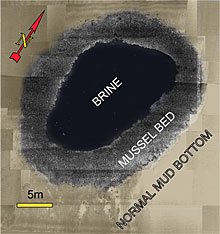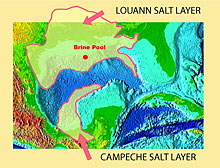
The Brine Pool is a crater-like depression on the seafloor filled with very concentrated brines coming from the Luann Salt Layer. The brine contains a high concentration of methane gas that supports a surrounding dense mussel bed. Click image for larger view and image credit.
Lakes Within Oceans
Bob Carney
Louisiana State University
One of the sites we will explore during the expedition is called the Brine Pool, which is a small lake on the seafloor with a distinct surface and shoreline. It exists inside of the ocean because its very salty water is denser than the surrounding water. Indeed, the Gulf of Mexico contains brine lakes as small as 1m across and up to 20km long. These lakes are created by a process called salt tectonics, which refers to the movement of large salt deposits.
Today, the Gulf is a deep basin, but during the middle Jurassic period, it was a shallow sea that became cut off from the world ocean and dried out, producing a thick layer of salts and seawater-derived minerals up to 8km thick. When the region rifted apart, it reopened the ocean connection, stretched the Gulf, and resulted in a dramatic deepening of the basin. During this rifting, the salt layer was broken into a large northern layer termed the Louann Salt Layer that extends underground as far as southern Arkansas and as far south as the base of the continental slope. The fragment in the south, called the Campeche Salt Layer, is much smaller and underlies the slope off western Yucatan.
When the Gulf refilled with seawater, the fractured salt layers were preserved from dissolution by a covering of sediment. They were buried deeper and deeper by subsequent sedimentation. Eventually, the overlying sediments became so heavy that they began to deform the salt, forcing it to move. This movement—salt tectonics—has dramatically sculpted the overlying sedimentary structures. In places, the salt layer erupted through the sedimentary structures as domes, creating large mounds and ridges on bottom. Elsewhere, the salt was squeezed out, causing the sediments to drop down into a low basin.

The Brine Pool and other brine lakes in the Gulf of Mexico are caused by dissolution of buried salt deposits created during a time when the Gulf dried out. Now broken into two large sheets, movement of the salt sculpts the seafloor, which creates unique habitats. Click image for larger view and image credit.
The net result is a continental slope pocketed by ridges and basins. At the edges of the salt layer, tectonic movement tends to be lateral as the weight of sediments presses the layer out. This migrating salt edge is evident in the Sigsbee escarpment of the northwestern Gulf, the steep terminus of the continental slope. Although termed an escarpment, this cliff is quite unlike the carbonate escarpments of west Florida and Campeche. Rather, it is shorter, less steep and muddy.
Salt migration upward and outward may be the primary force that turns seeps on and off. The relationship between salt and chemosynthetic communities, however, probably extends beyond simple physical puncturing and draining of hydrocarbon deposits. When salt deposits come into contact with seawater, they dissolve, and form brines many times saltier than seawater. These heavy brines flow out of the seafloor in channels that result in puddles, pools, and even lakes of brine that are tens of kilometers long. Some have no obvious chemosynthetic activity associated with them other than bacterial action. Others, most notably the Brine Pool, have dense mats of methane-using mussels fringing their shores. The causes for such variation are not known.
Sign up for the Ocean Explorer E-mail Update List.























